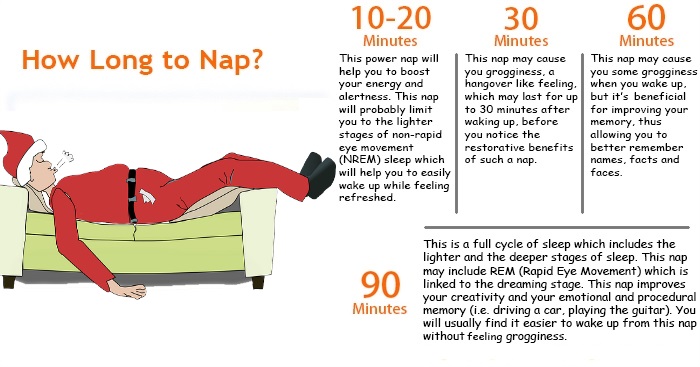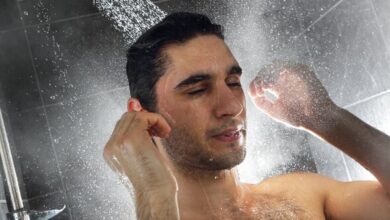The Benefits of a Power Nap and How to Take the Perfect Nap – According to Science
Generally speaking, a short power nap of 10-20 minutes is good for a quick improvement of your alertness and energy level and will enable you to get back to work quickly.
A nap of about 30 minutes will provide you a mental sharpness similar to the 10-20 minute nap, with that sharpness lasting a bit longer, but the downside is that people tend to feel groggy immediately after this kind of nap.
A longer nap of 60 minutes is good for your cognitive memory. It can help you remember faces, names and facts, but the downside is some grogginess upon waking.
A long nap of 90 or more can provide you a full sleep cycle which improves procedural memory (such as riding a bike or playing the piano) and creativity. Waking up after it usually has minimal amount of grogginess.
So to summarize, if you are looking for a quick boost or recharge, you are looking at a short nap length of about 10-20 minutes. However if you are looking for deeper sleep rejuvenation, you are looking at a longer nap of about 60-90 minutes.
The Benefits of a Power Nap
Let’s look in more detail how power naps can work for you to improve memory, increase learning, become more efficient and generally function better.
Power Nap Improves Alertness
One of the instant benefits of taking an afternoon power nap is that you will feel more alert.
Researchers have found that a brief power nap of between 5 and 15 minutes can make you immediately feel more alert. One study showed that the effects of a short nap can last for up to 3 hours. A longer nap of 30 minutes also helped to improve alertness with the effects lasting for many hours. (4)
One 2019 study found that a 30-minute nap at 1:00 p.m. boosted cognitive function and restored alertness. The study also showed that an afternoon nap can help to improve physical performance and reduce fatigue. (5)
Some studies show that napping is as effective as drinking coffee to increase alertness. However, other studies reveal that the benefits of a 15-minute nap can be enhanced by having a coffee just before your nap or washing your face. (6)
Another study showed that taking a cup of coffee after a 15-minute nap can help make you more alert when driving. (7)
Power Nap Improves Productivity
Enjoying a short nap in the afternoon can also help boost your productivity at work.
The journal PLoS One found that the best time to nap is between 2 p.m. and 4 p.m. which is when you may feel the sleepiest. Researchers have found that napping for 15 to 45 minutes between 12:30 and 14:00 is the most effective time to increase productivity. (8)
However, a long nap seemed to negatively impact on alertness and productivity.
One study found that napping for 30 minutes or less was good to enhance learning ability and performance. (9)
A small study found that 20 minutes nap in the mid-afternoon had positive effects upon maintaining daytime vigilance level, and improved performance level and self-confidence of the participants in their task performance. (26)
Power Napping Improves Memory
The benefits to your cognitive function of taking a nap after lunch can also help to boost your memory.
Studies have shown that regular napping can benefit your long-term and short-term memory.
A 2019 study published in the journal Sleep found that napping can help to improve memory function over the long-term. Taking a nap was more effective than taking a break and helped young adults retain more information when studying. (10)
Studies have also shown that a quick nap during the day can benefit short-term memory. For example, a study involving 145 female shift workers found that those who napped had better alertness and cognitive function than the non-nappers. (11)
Another study reported that napping after lunch benefits short-term memory, accuracy, and alertness. (12)
Power Naps Boost Endurance Performance
Dozing after lunch for 20 minutes or so can also improve your energy levels and increase your performance.
The European Journal of Sport Science in 2018 reported that athletes who napped for between 20 and 30 minutes performed better. Napping in the afternoon was a good way to reduce the effects of sleep deprivation. (13)
Power Nap Promotes Good Heart Health
A meta-analysis on the effects of napping on your heart health found that a short nap can lower your risk of heart disease. The perfect length of time for a nap to promote good heart health was under 30 minutes. Interestingly, regularly napping for an hour or more during the day was associated with an increased risk of heart disease. (14)
One of the reasons why a power nap is good for your heart is that it helps improve your circadian rhythm. This has been shown to lower stress levels and blood pressure – both of which can impact on your health. (14)
The researchers believe that an afternoon nap may contribute to stress-releasing process, which can help reduce mortality from coronary heart disease.
A large research from the Harvard School of Public Health and the University of Athens Medical School found that midday napping reduced coronary mortality by about one third among men and women. The study found that people who regularly took naps at least three times per week for an average of at least 30 minutes, had a 37% lower coronary mortality than those not taking naps. (25)
Power Nap May Help Control Blood Pressure
Enjoying a short siesta can also be good to manage high blood pressure.
For example, one study found that blood pressure drops during a short afternoon sleep when compared to being awake. (15)
Other studies have shown that power napping in the afternoon can be more beneficial for your blood pressure than just relaxing while awake. (16)
Power Nap Boosts Your Immunity
Having a power nap after lunch is also good for your health in general because it can boost your immune system.
Researchers have come to realize that getting enough sleep is necessary to strengthen your immune system. There is also evidence that a brief nap can also give your immunity a needed boost.
One study found that napping is a good way to offset some of the negative effects sleep deprivation has on your immunity. Getting a 30-minute nap helps to normalize your body’s immune response. (17)
A power nap is one of the great hacks to quickly get your immunity working as it should. You can also learn what else you can do to prevent infection due to a weakened immune system.
Power Naps to Help Relieve Stress
A 30-minute power nap can also be good to deal better with stress and avoid the consequences of being constantly stressed.
Getting enough sleep helps your body produce hormones that are associated with lower stress levels. Taking a nap can help to normalize hormone levels if you haven’t had enough sleep.
The Journal of Clinical Endocrinology & Metabolism reported that napping has a stress-releasing effect. From various reports, it seems that the ideal nap time to relieve stress is around 30 minutes. The researchers also found that this nap length helped boost immunity and cardiovascular health. (18)
A study involving night-shift workers found that taking two 15-minute naps helped to relieve tension and calm the nerves. (19)
Other studies have found that short naps are good for helping to reduce psychological and physiological strain. (20)
Power Nap Could Help Improve Depression and Boost Mood
Having a short sleep in the afternoon can be one of the ways to improve your mood and manage depression.
One trial involving people with depression found that napping after a sleepless night was beneficial. The patients napped for 10 minutes during the day and researchers noted they had fewer symptoms of depression after the nap. (21)
Another study found that a power nap has many benefits for people with depression. The study found that napping between 2 p.m. and 3:30 p.m. helped to improve the general well-being of depressed people. (22)
Taking a nap in the afternoon can also boost the mood of people who don’t have depression. One small study found that a short 20-minute nap helped to boost mood and have a positive effect on cognitive function. (23)
Power Napping Increases Testosterone in Men
A power nap after lunch can be good for male sexual health because it boosts testosterone levels.
Studies into the effects of hormone production during sleep have found that levels of testosterone increase while sleeping. This is one reason why men who regularly nap seem to have higher testosterone levels in the afternoon. (24)
Tips for the Perfect Nap
Power naps can really help to improve your mood, alertness, learning ability, and general well-being.
What can you do to enjoy the perfect power nap? And when is the best time to go for a nap?
Most studies show that your body naturally becomes drowsier in the 2 or 3 hours after lunch. So, generally, power naps are best enjoyed in the early afternoon or not long after eating lunch.
Most of us feel tired between 1 and 4 pm, so try to fit your nap during those hours. Don’t make it later otherwise it can interfere with your ability to fall asleep at bedtime.
Here are some ways to enjoy the perfect nap:
Don’t nap too long. A power nap is never meant to be too long. Usually, napping between 10 and 30 minutes is the ideal length of time for a nap. If you nap too long, you may feel drowsy for the rest of the day.
When taking shorter naps, it is recommended to sleep partially upright to make it easier to wake up and to avoid falling into a deeper sleep.
Create the right environment. You will fall asleep for a short nap easier if you are in a dark place that isn’t too warm.
Time your caffeine right. Some power nappers find that taking a cup of coffee right before napping is effective. Studies have shown that this helps you to wake up more alert after your power nap. (6)
Try relaxing beverages. You can avoid the stimulating effect of caffeine by taking a relaxing herbal tea before or after your power nap.
Have a light snack. Did you know that there are some foods that make you sleepy? Take a glass of warm milk or eat a banana to help you fall asleep faster.
Remove distractions. Make sure that you won’t be distracted during your 10, 20, or 30-minute power nap. So, put your phone on a flight mode if using it as an alarm clock.
Try the 4-7-8 exercise to fall asleep.
Try to nap at a regular time. If your schedule allows for it, try to schedule a power nap for the same time every day. This way you teach your body to expect the nap and you may find it easier to fall asleep.





